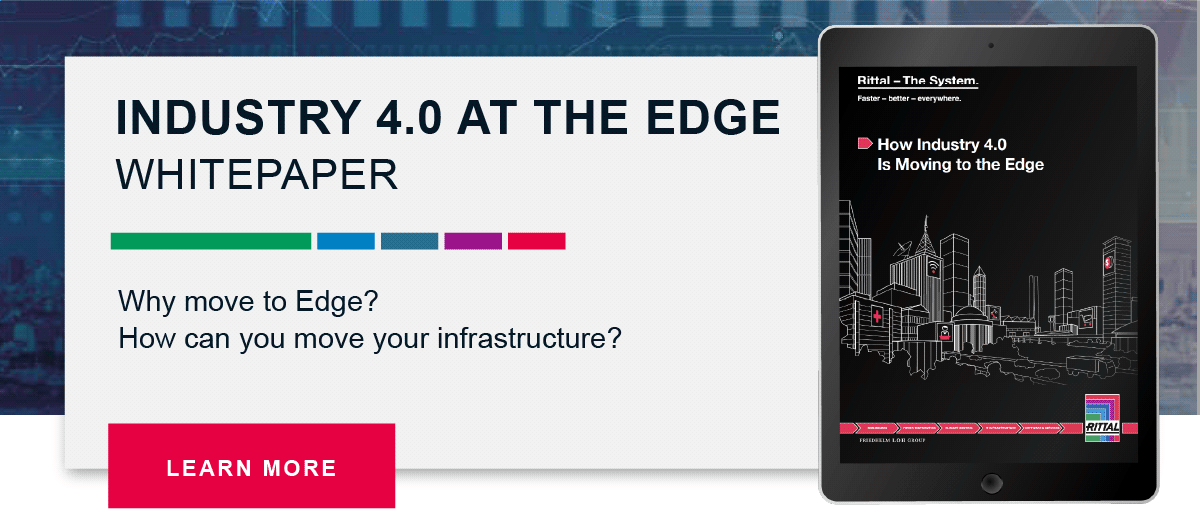4 Key Decisions to Make When Designing an Edge System
Edge computing is quickly gaining momentum as more and more organizations take advantage of high-speed processing at a very local level, with the goal of optimizing use of data to improve operations. The military, manufacturing/industrial, retail, telecom, financial service, healthcare, transit...just about any type of organization is moving to the Edge to enable them to leverage data faster, save money, free up bandwidth and improve overall operational efficiencies.
Each Edge deployment comes with its own unique scaling, cooling and safety needs, and there’s certainly no “one-size-fits-all” solution. When designing your Edge system, several factors need to be considered, and we’ve outlined some of the most important below.
But first, a definition: the Rittal Edge is on the factory floor, in the distribution center, the transit facility. It is next to a highway, down a shaft, out at sea. The physical location of The Edge is as close to the processes and applications controlling critical processes. It is not in a data space; it is standalone and exposed to a multitude of threats – physical, cyber and human. This Edge is where the critical factors described below are vital to a successful deployment.
Scalability
Scaling to accommodate future demands means designing a deployment that’s flexible – one to which you can quickly add accessories, reconfigure the enclosure (sometimes called a cabinet) to accept sizes of equipment, compartmentalize so that IT and power equipment can be installed in the same enclosure, and apply appropriate cooling methods as needed.
Modular enclosure solutions make scaling for The Edge even easier. These are essentially building blocks, made of components that can be rearranged without the need to cut or weld as you execute changes. Ease of reconfiguration to support adding new equipment to a modular enclosure, even if their dimensions are different from what’s already in the enclosure, becomes a simple task often accomplished without tools.
Some enclosures take simplicity a step further. Rittal’s modular enclosure options are available with common accessories pre-installed, making it possible to even more quickly scale to meet specifications. Cooling, cable management and PDU solutions come built in, making these enclosures a smart and efficient way to grow an Edge data center.
Infrastructure
New Edge deployments often call for investments in infrastructure to satisfy power and redundancy requirements. For example, a facility may need to add a backup generator, transformer, and switchgear; some deployments, like those in remote locations, may need high-voltage, three-phase electricity run to the site. Identify gaps by doing a thorough assessment of your facility’s current infrastructure as you prepare for a successful Edge deployment.
Infrastructure also includes security, both environmental and physical. It may be necessary to meet existing corporate or jurisdictional standards and to include them in the Edge installation.
Cooling
The most efficient system for your needs is going to be the one that is matched to the heat output of the racks, that provides adequate air flow to each rack, and that maintains the required temperature and humidity levels. Additionally, the climate control solution must also allow for environmental factors at the installation site – temperature extremes, solar loading if outdoors, exposure to the elements. As you evaluate your cooling options, we recommend looking at these primary factors:
- Type of liquid. For a multi-footprint installation, cooling at the Edge is best done by refrigerant based systems; depending on the environment and availability, a water based system could also be considered.
- Refrigerant-based cooling is ideal for indoor environments and low thermal loads (2 - 20kW). Start with a cabinet mount air conditioner for one or two load low footprints up to a close coupled DX system for multiple footprints
- Water-based systems offer exceptional cooling properties, well suited to the high heat output of an Edge systems with higher thermal loads or exposure to extreme high temperatures
- Either is ideal for a space that has no other climate control available
- Average temperatures to be maintained. Generally, equipment should be maintained at a temperature between 70° - 80° F, but your equipment’s set point will depend in part on the heat output calculations of the enclosures. For a higher density installation, more cooling power may be required to offset these higher heat loads
- Air flow. To ensure efficient air flow, you need to calculate the specific requirements for your racks. It’s also important to understand which way the airflow will be directed (front-to-back is ideal, but you need to plan based on how the heated air is to be discharged). Air flow could also influence the type of liquid cooling – in-rack, in-row or a combination of both
- Ambient conditions. Temperature extremes within the environment of a manufacturing facility, as an example, will affect the energy needed to maintain the ideal rack temperature. Whether (and how much) the ambient temperature will affect cooling will depend on the efficiency of the system, and the heat being generated by the equipment
- Load fluctuations. If your Edge installation will see variations in energy use, the cooling system you choose should be adaptable to those changing conditions
The Best Cooling for Edge Systems
Based on the factors above and others you’ll need to consider, one of the best cooling solutions for Edge deployments will be a closed loop liquid cooling system. Here are just some of the advantages:
- Lower cost. In closed loop systems, racks and heat exchangers work exclusively with one another, optimizing air flow and efficiency. They also power down when the temperature inside the enclosures reach a predetermined ideal temperature, reducing the unit’s duty cycle (and, in return, energy costs), unlike traditional room-based cooling systems, which are “always-on”
- Monitoring. A closed loop system constantly monitors and regulates operational parameters to ensure that optimal heat removal and temperature are maintained
- “Cleaner” cooling. With solid doors (front and rear) installed on the rack enclosures, climate control is rack-based. No dust, dirt or ambient moisture from outside the enclosure is introduced into the loop, helping maintain peak equipment performance
- Ideal for heavy thermal loads. Whether supporting a single enclosure or multiple footprints in a row, closed loop systems more effectively extract heat in high density applications (even in extreme temperature conditions), removing the heat directly at the point where it is being generated
- Equipment performance. Because closed loop systems maintain the ideal temperature inside the enclosure, both the performance and lifespan of the equipment is optimized
Safety
In addition to securing the facility and individual enclosures to prevent unwarranted access, fire detection and suppression features within the enclosures are important, too. For continued equipment operation, it’s critical that the extinguishing medium does not affect the electronics, so the medium must be non-conductive and leave no residue.
Several other factors will influence how your Edge system is designed and the features you look for in your rack enclosures. Learn more about all that’s involved in bringing data closer to where it’s needed by downloading our free guide, “Industry 4.0 is Moving to the Edge.”




